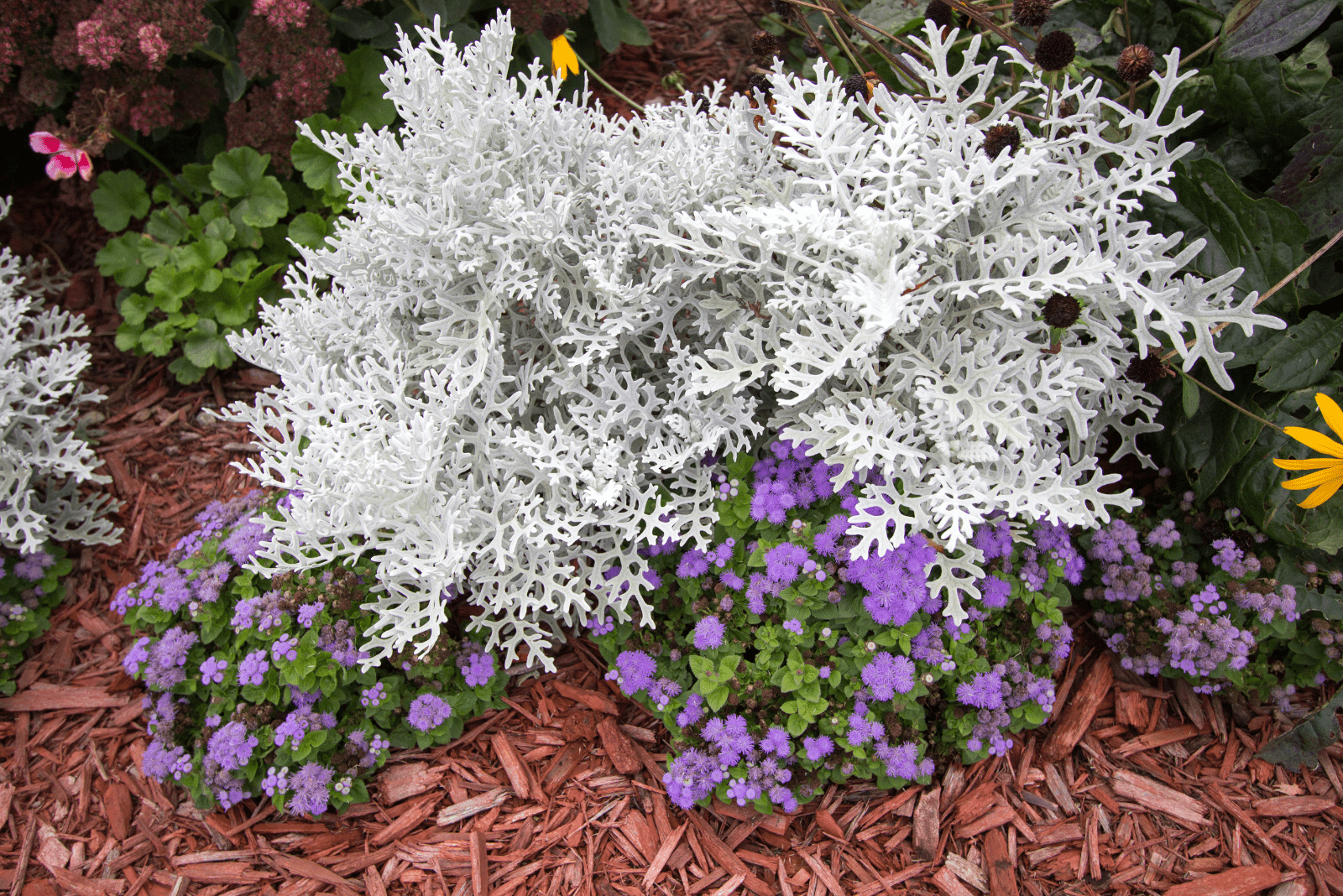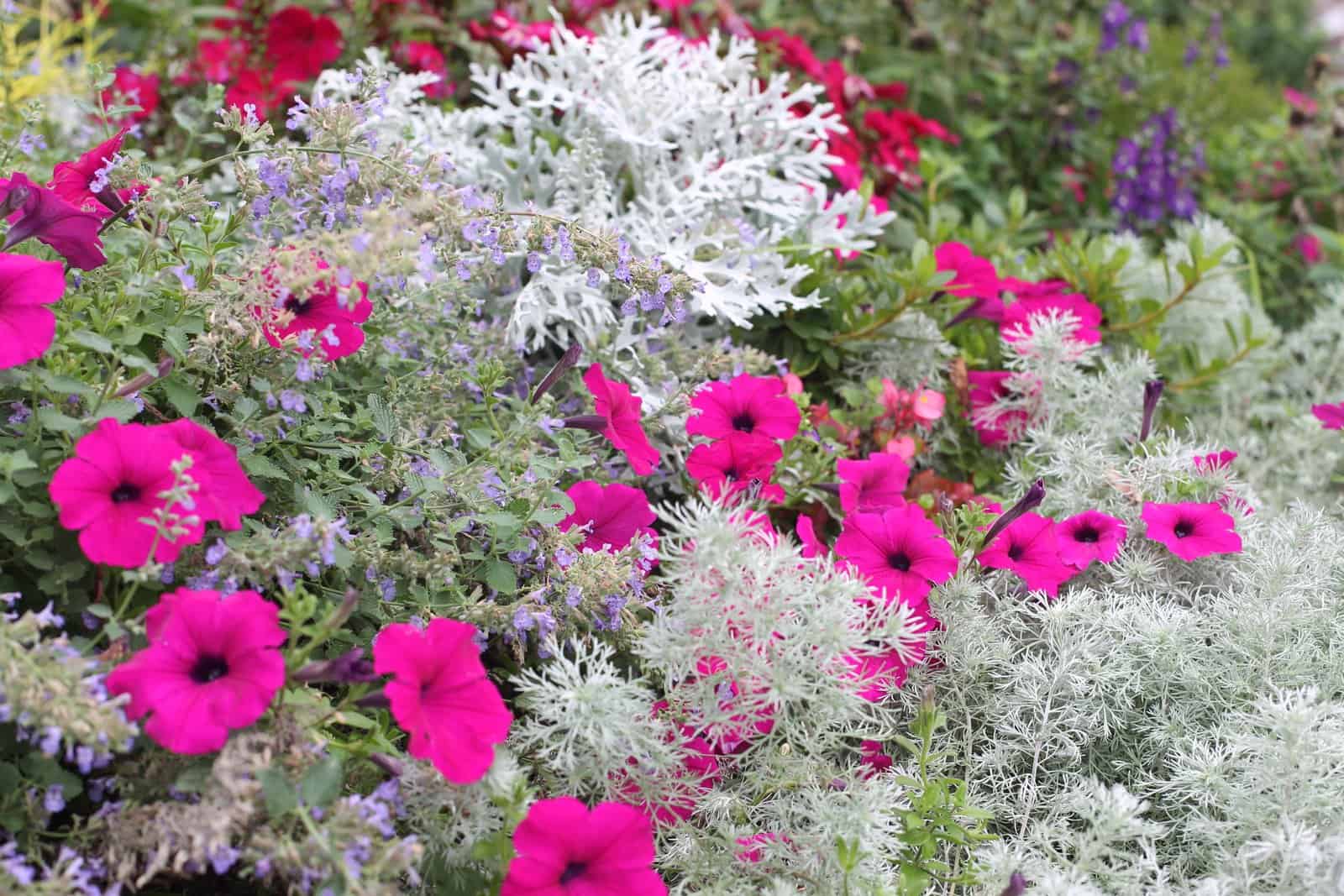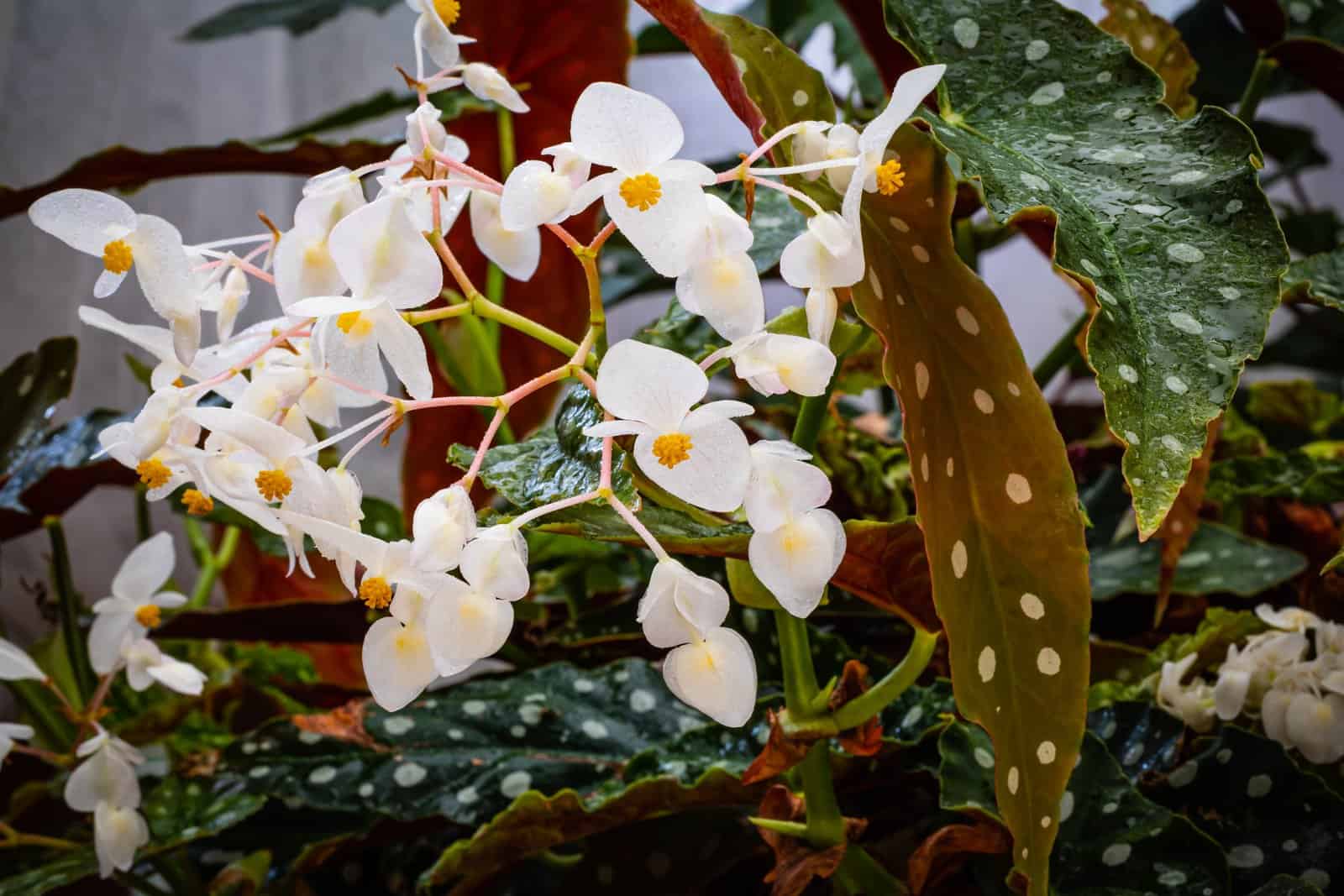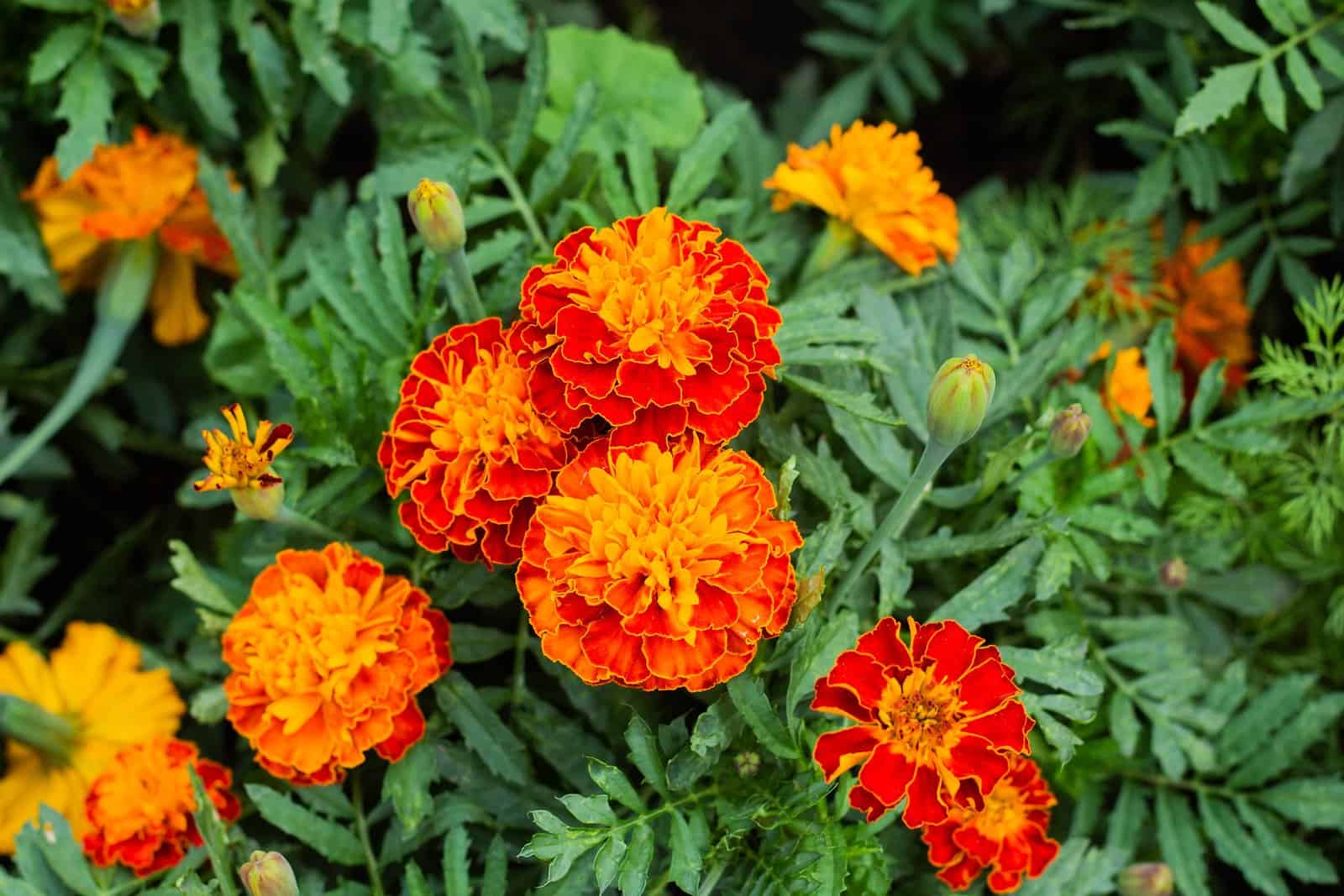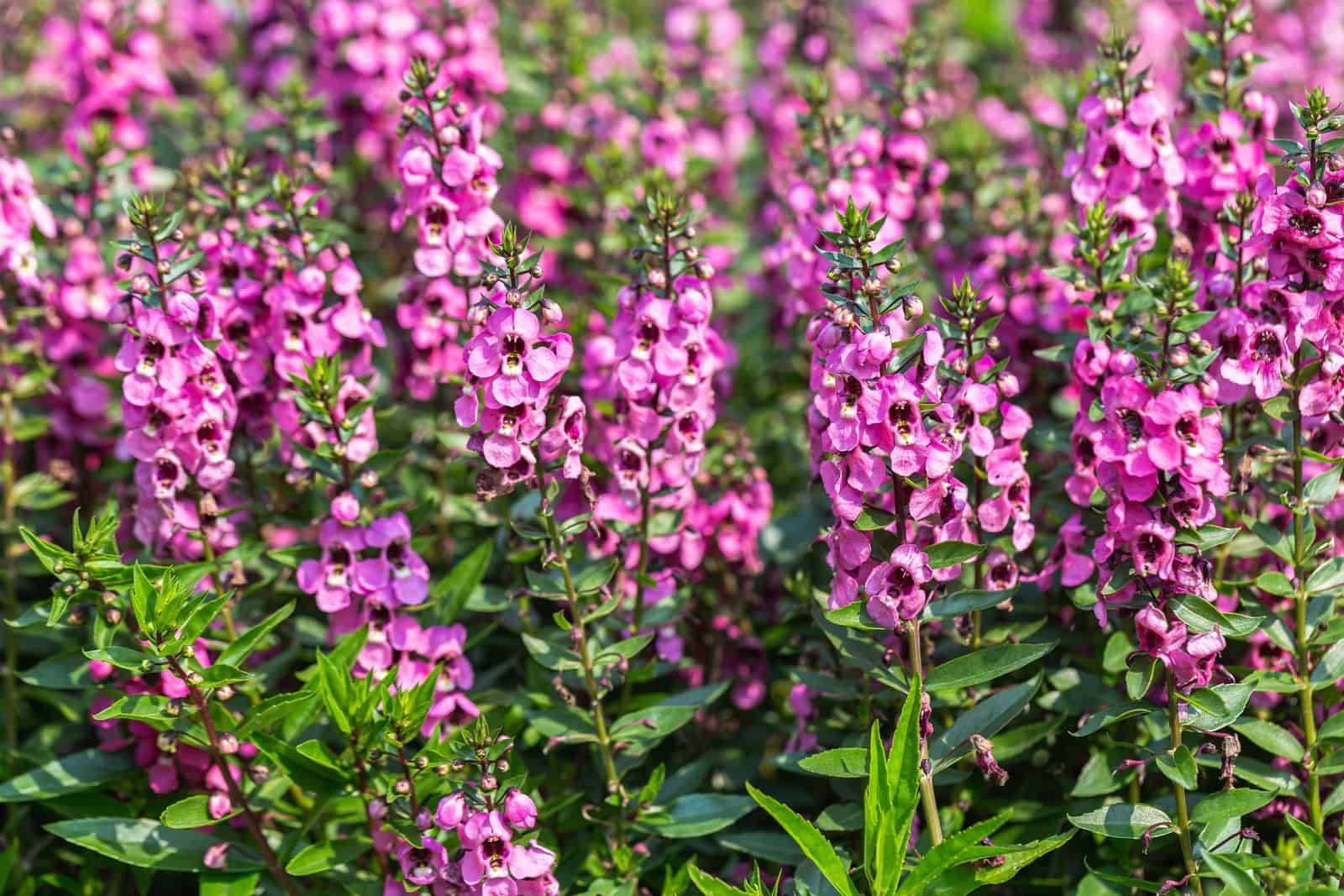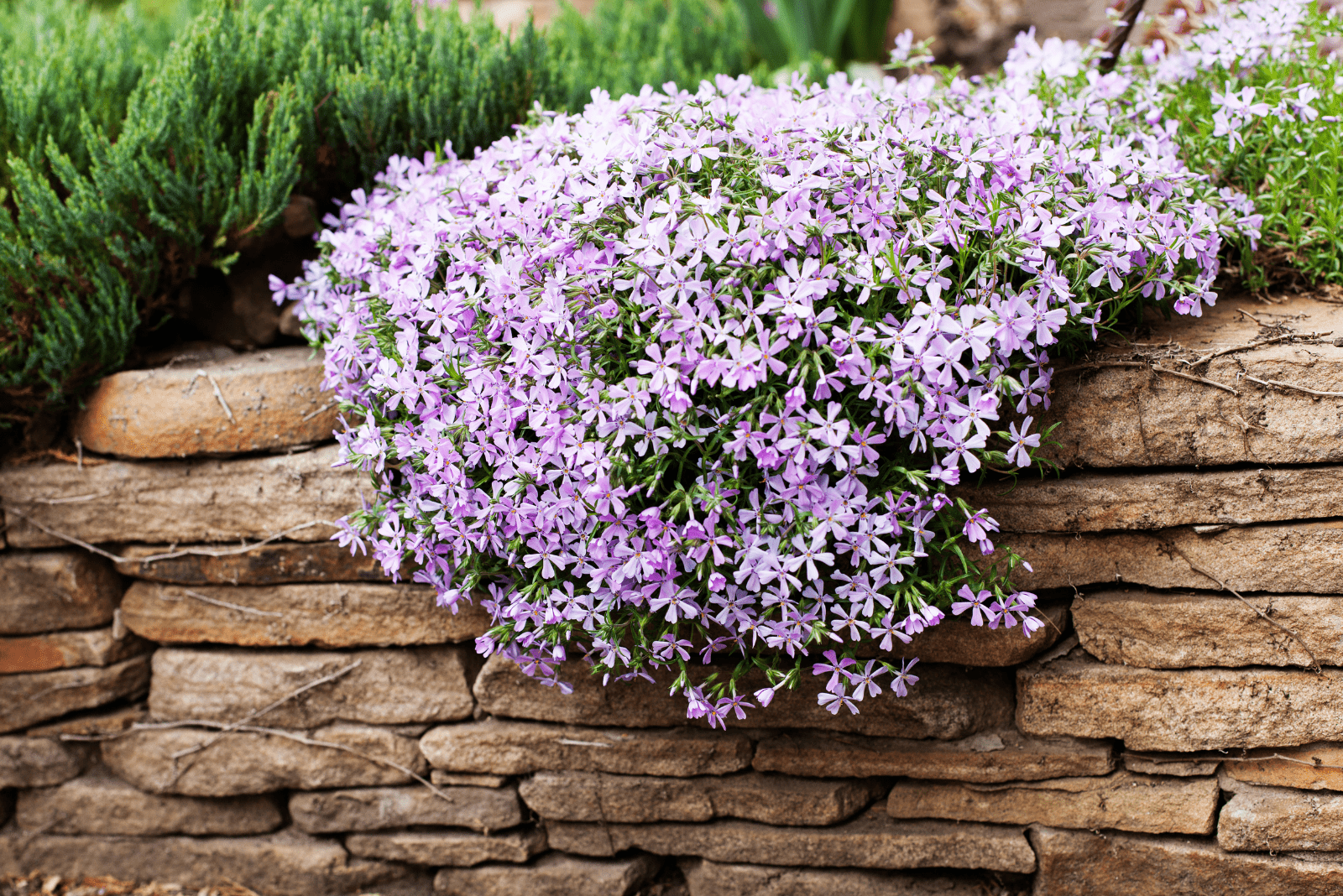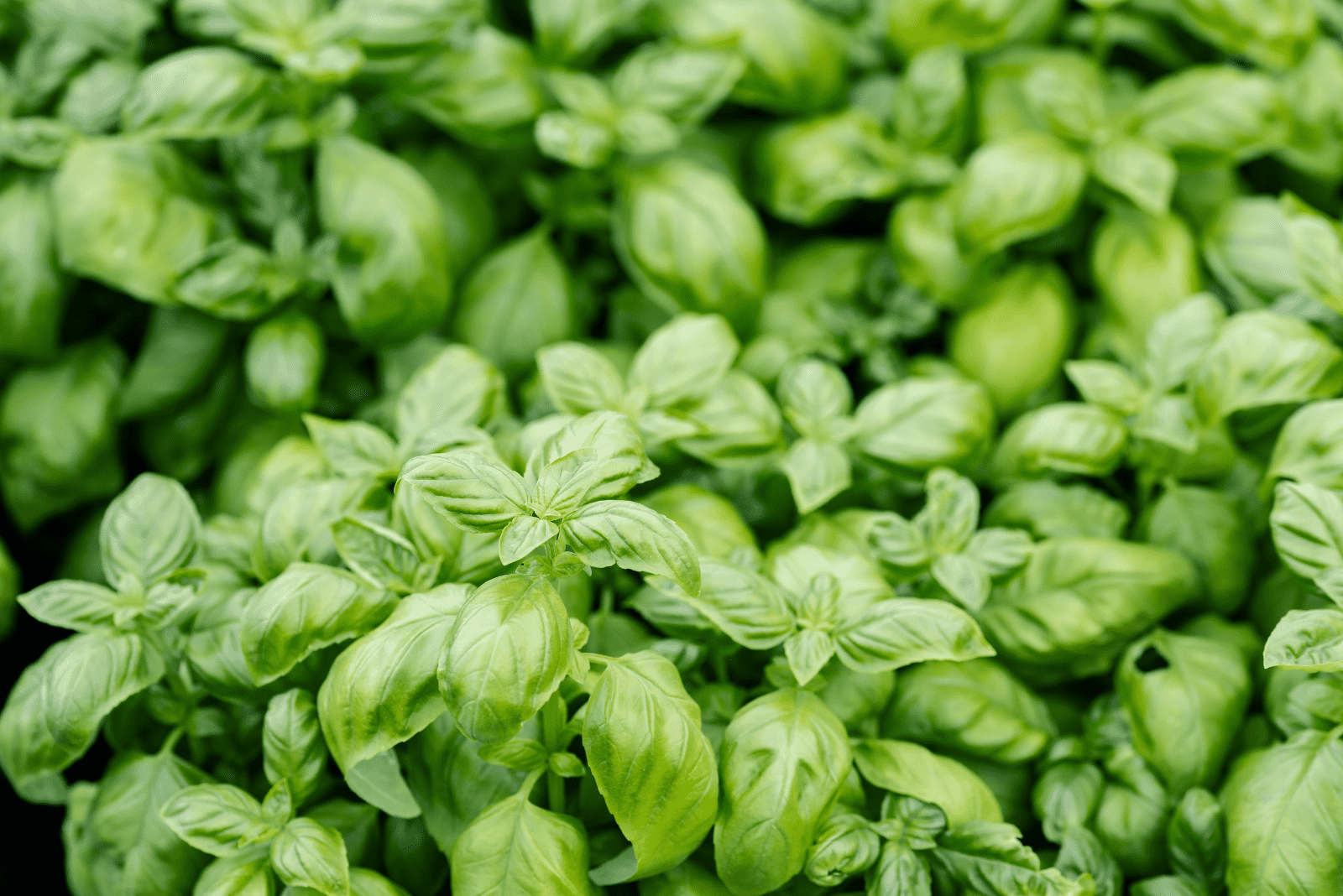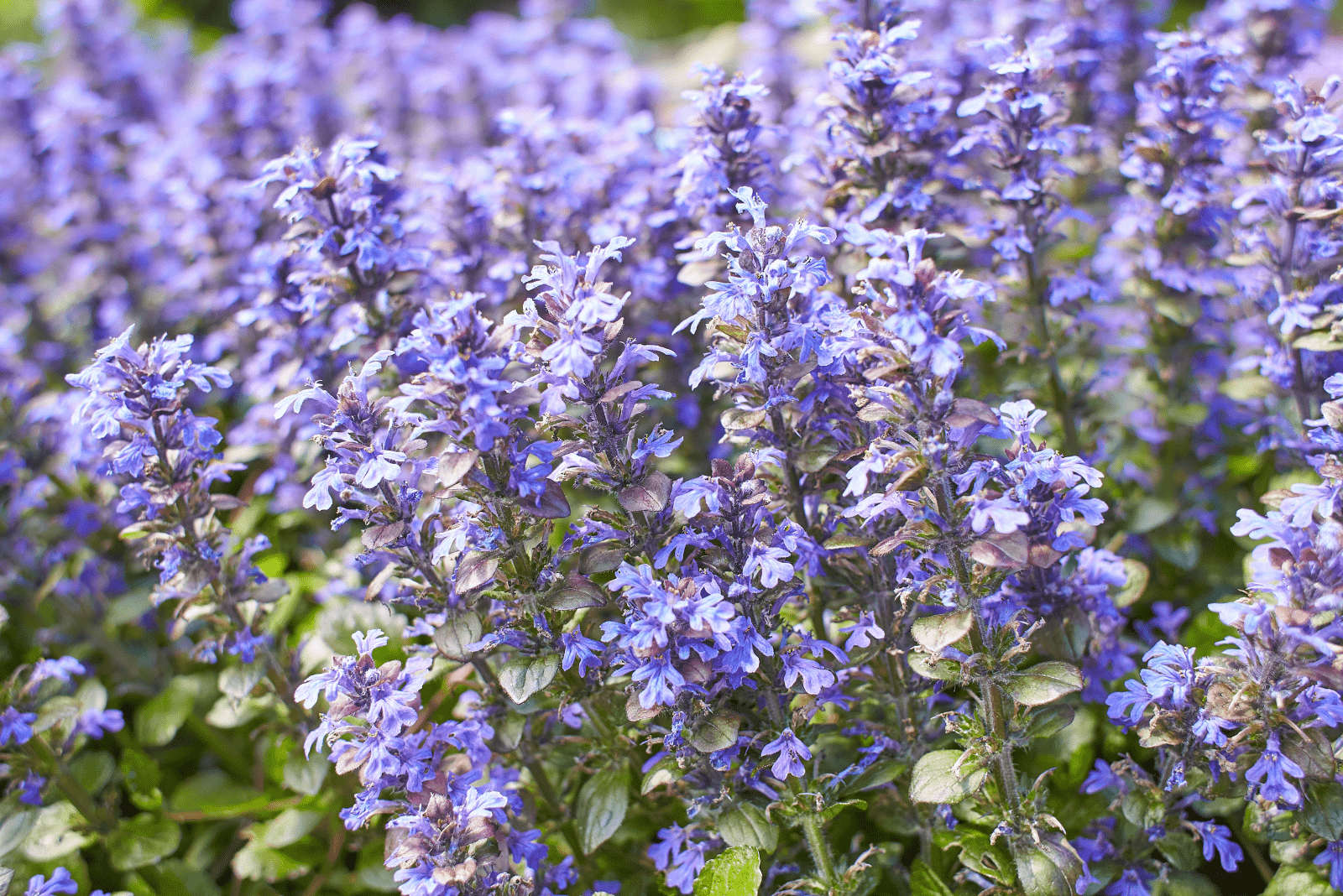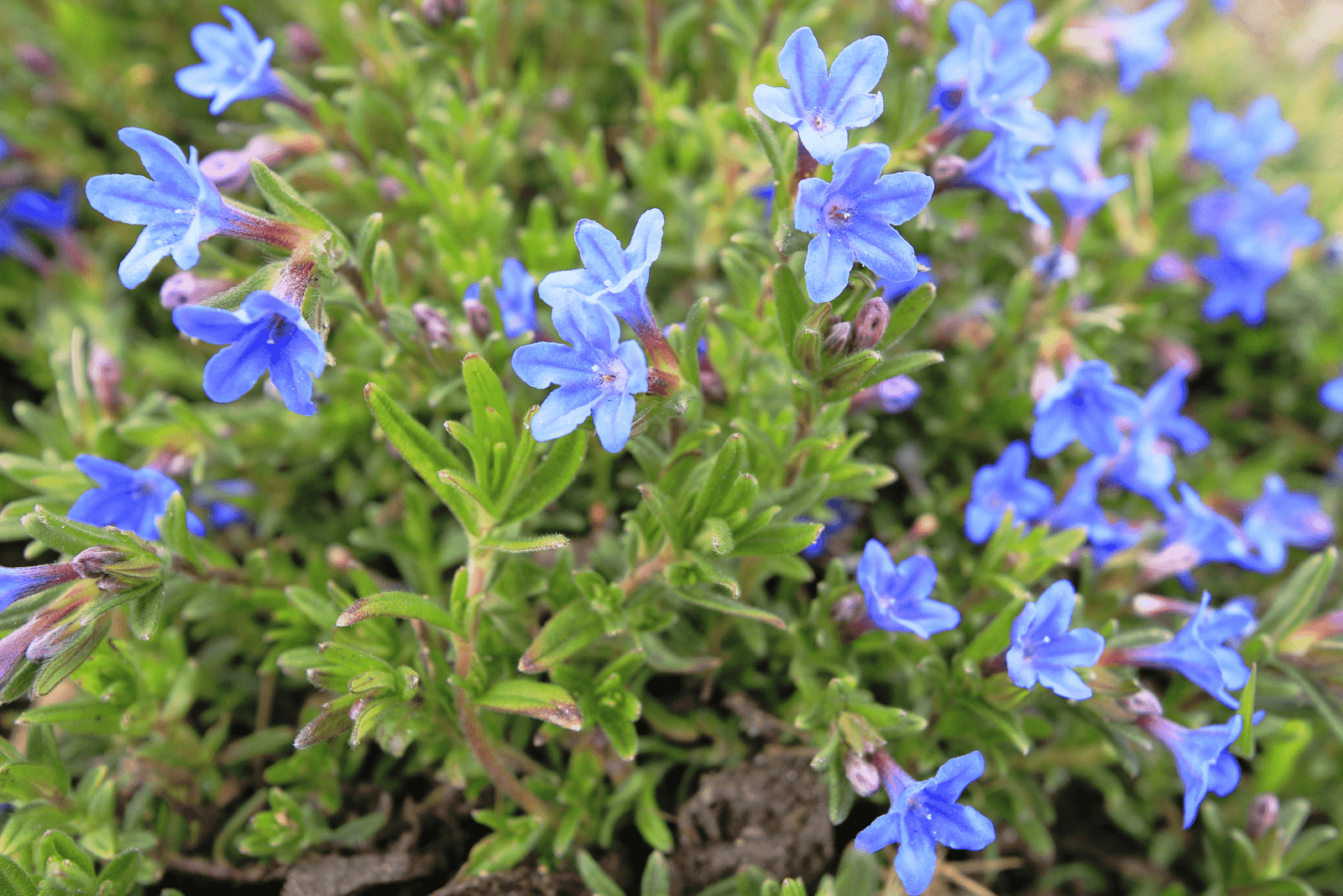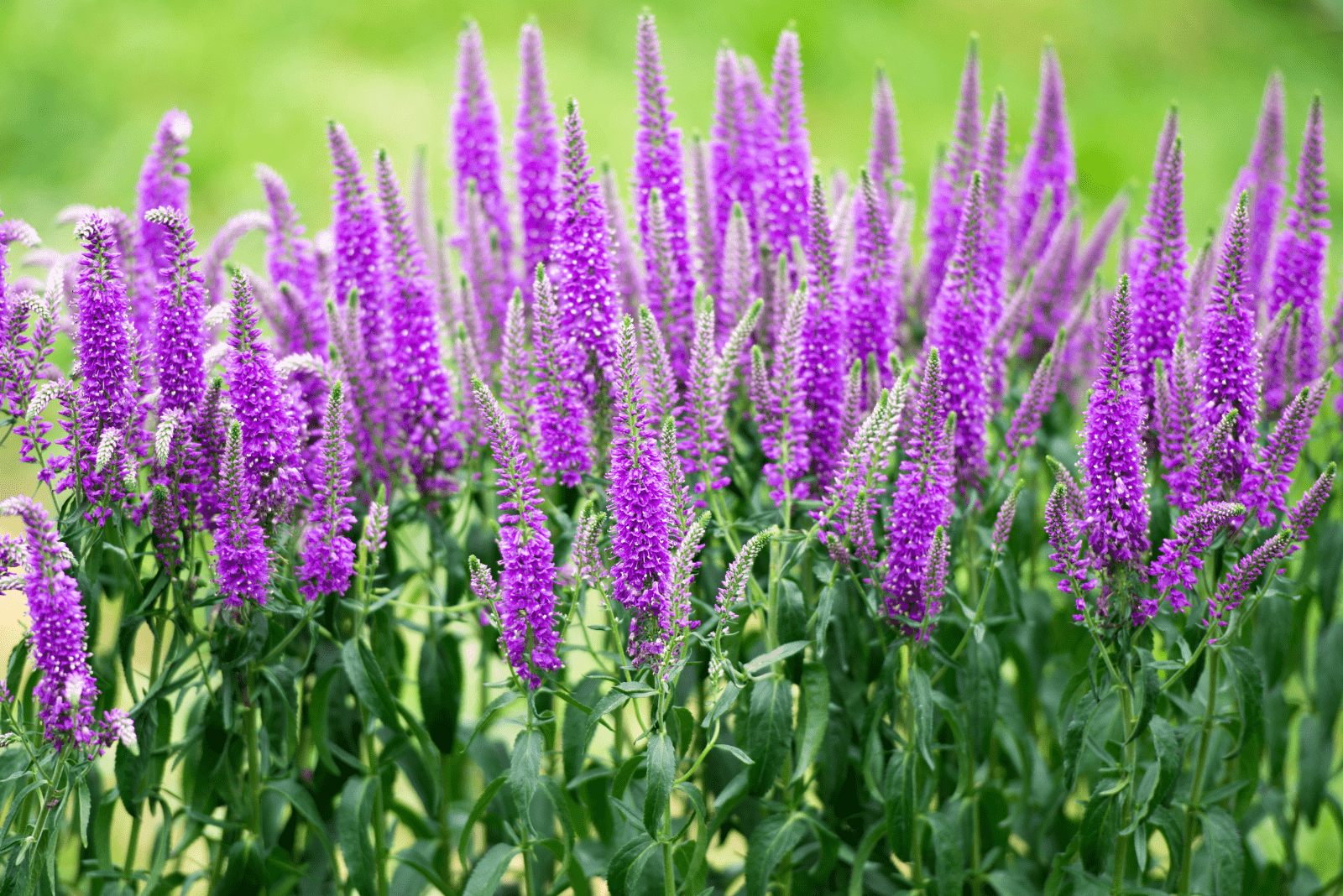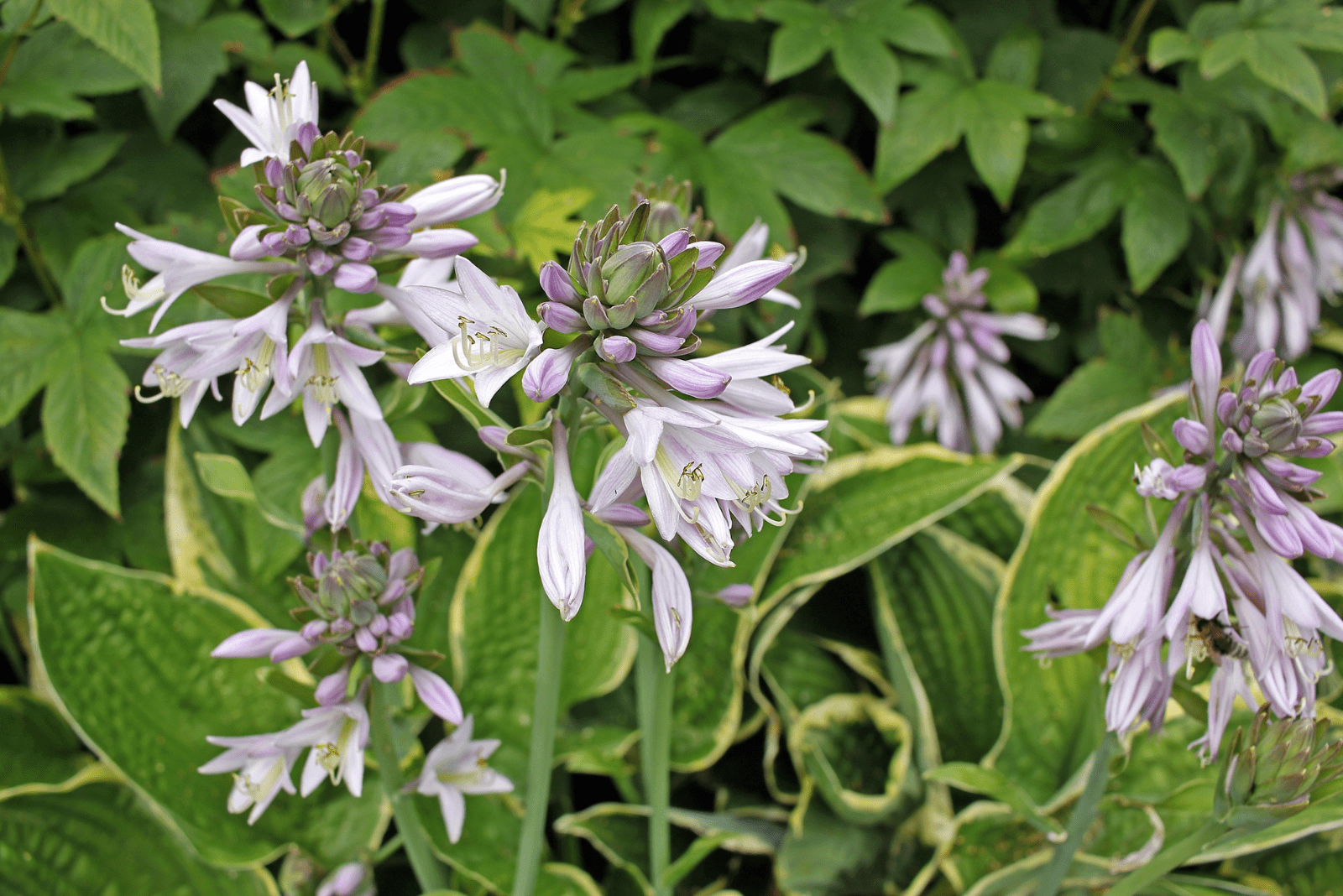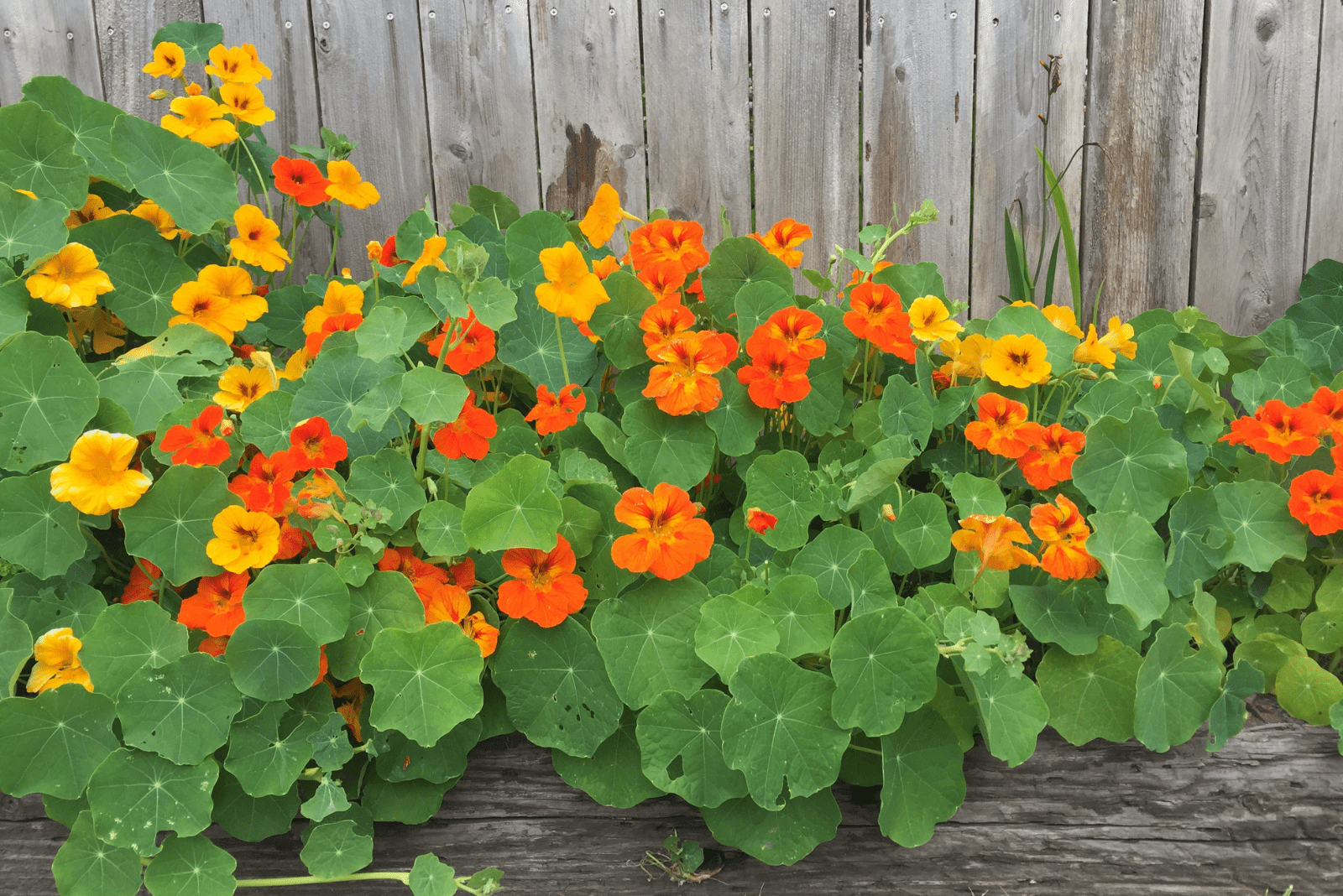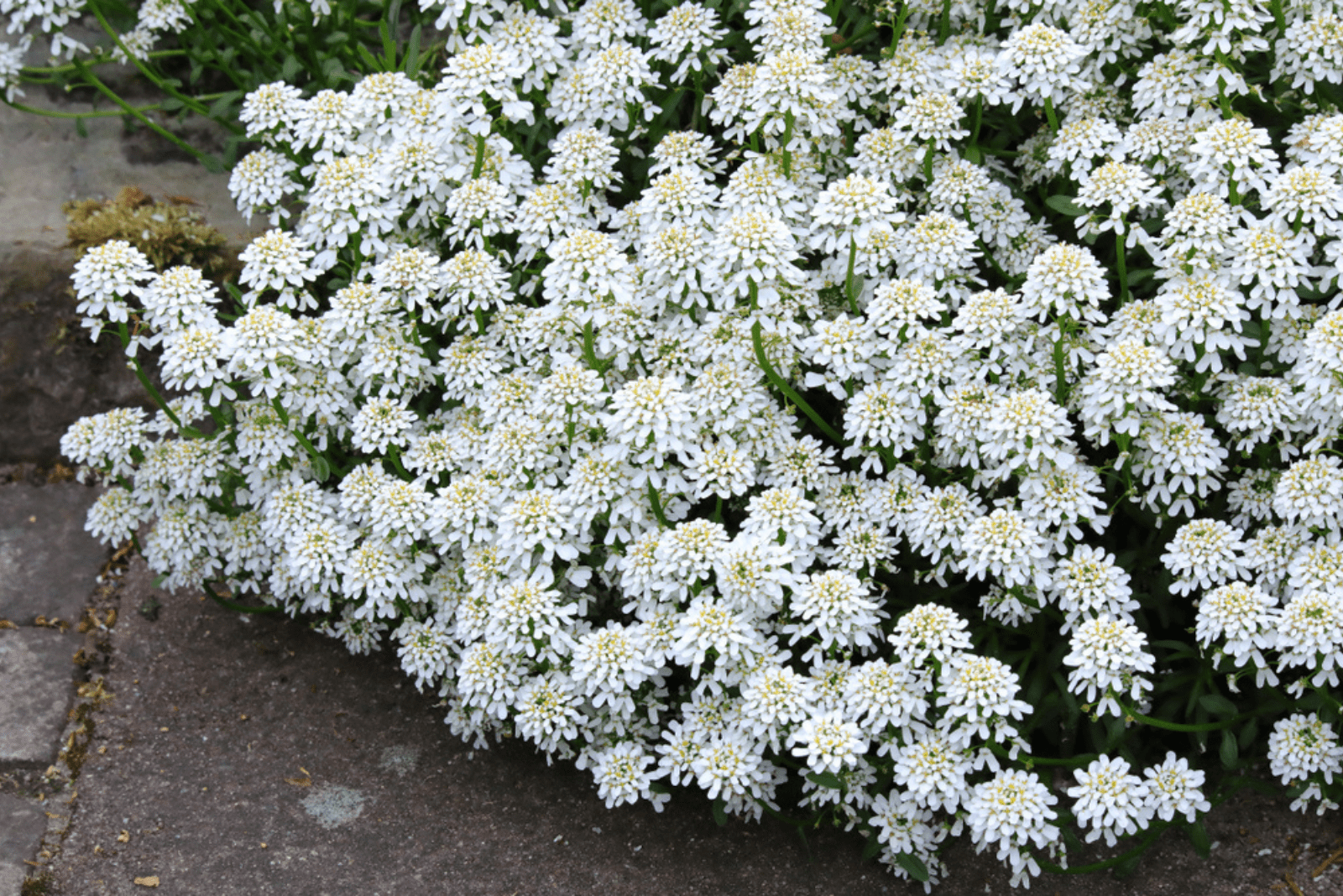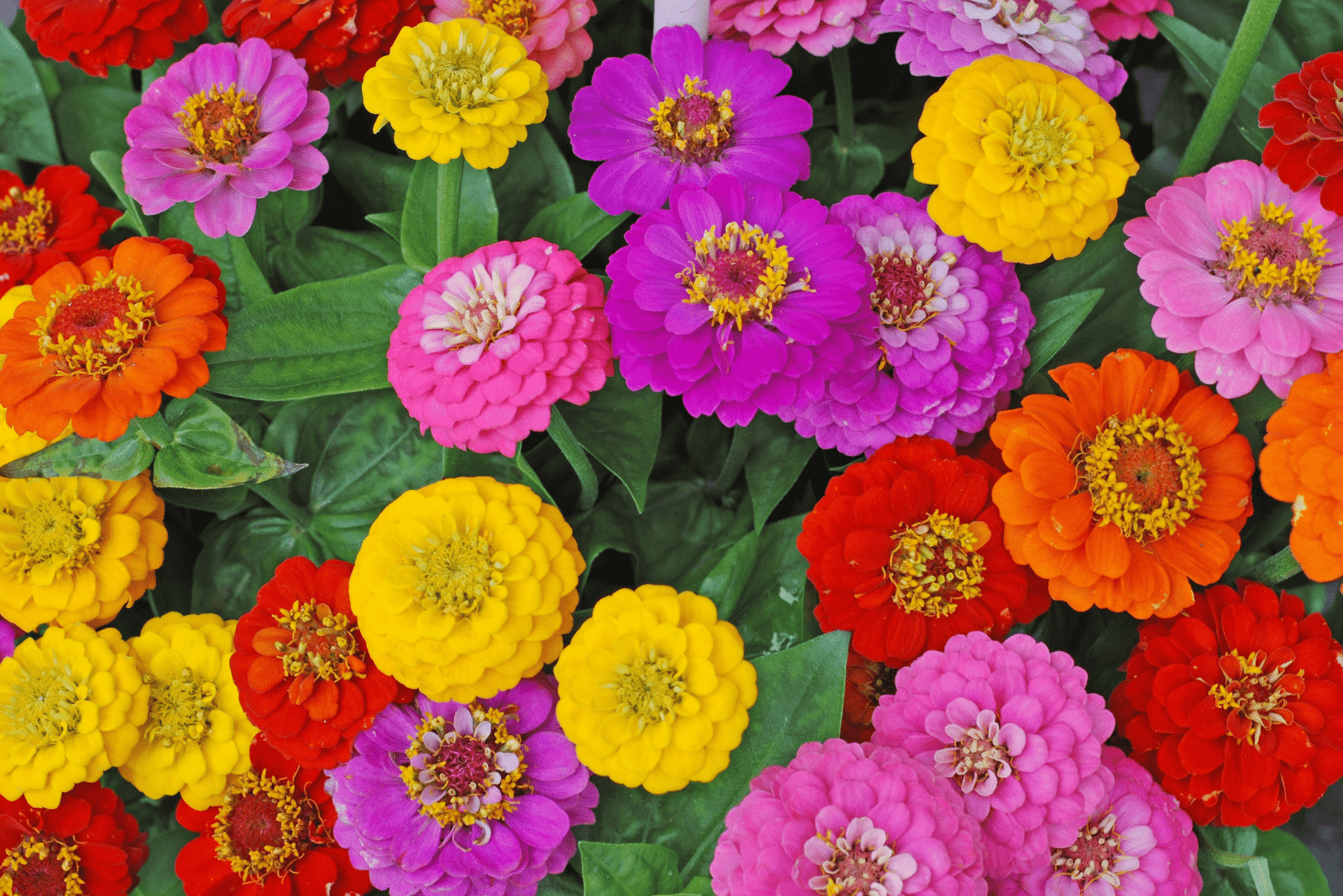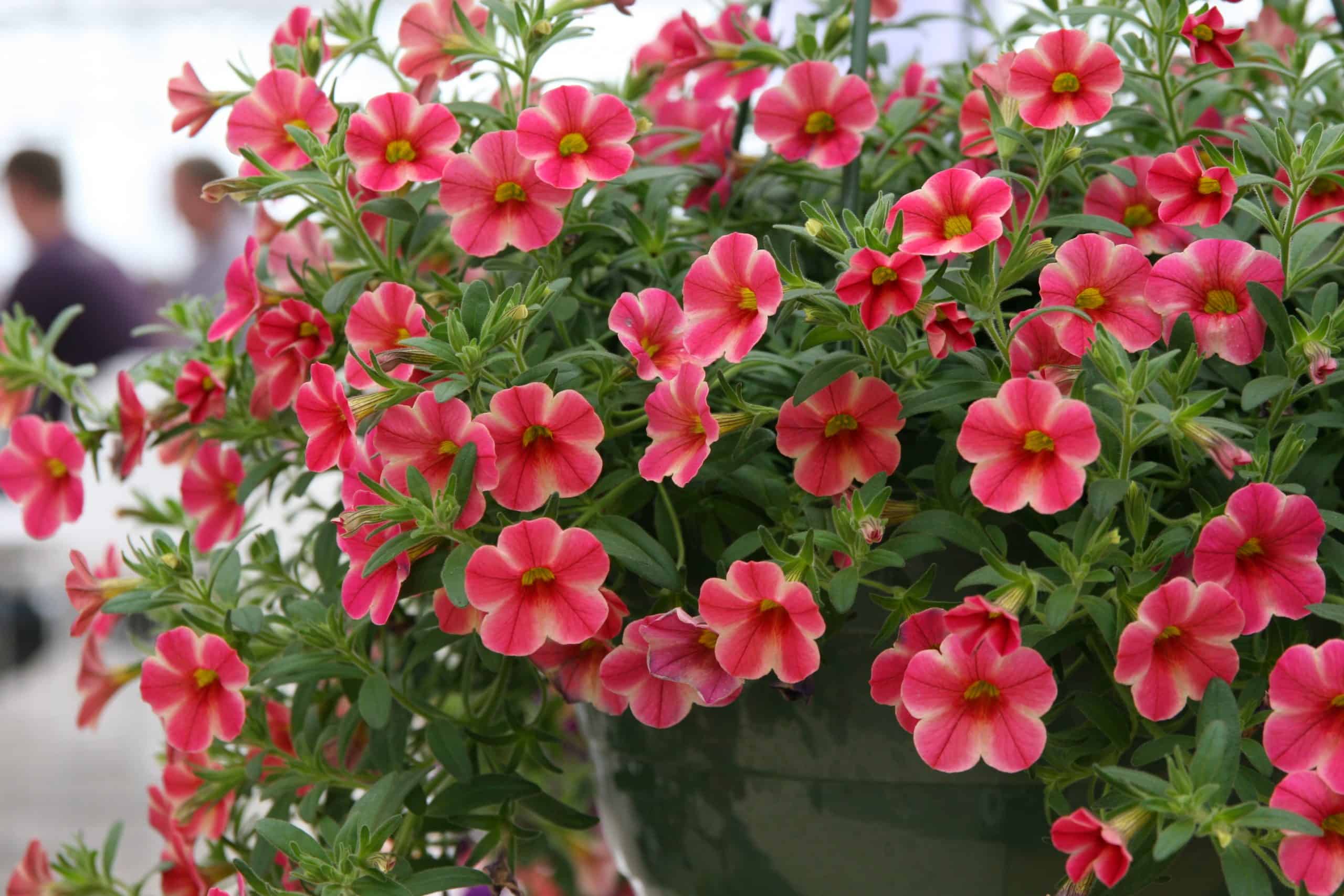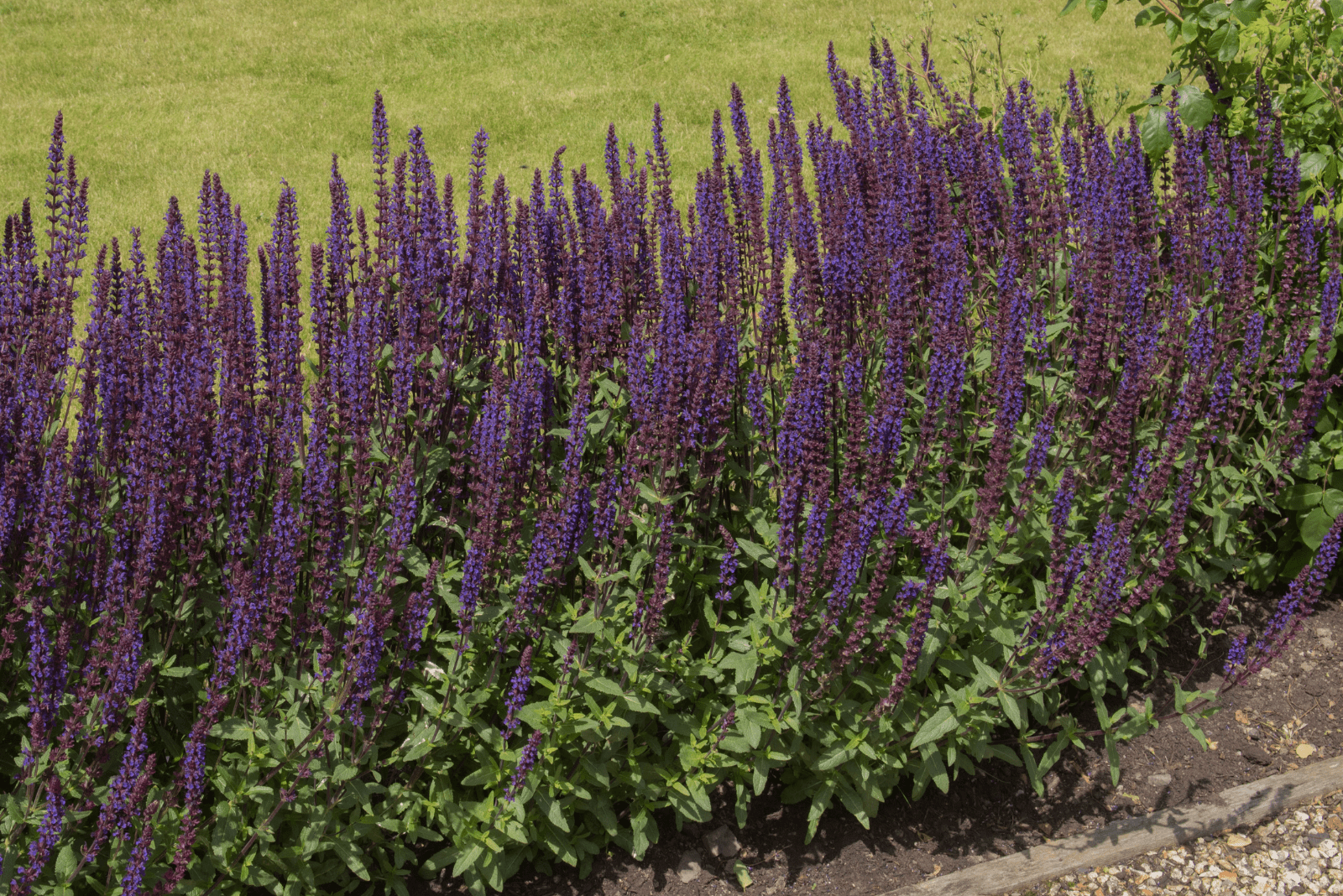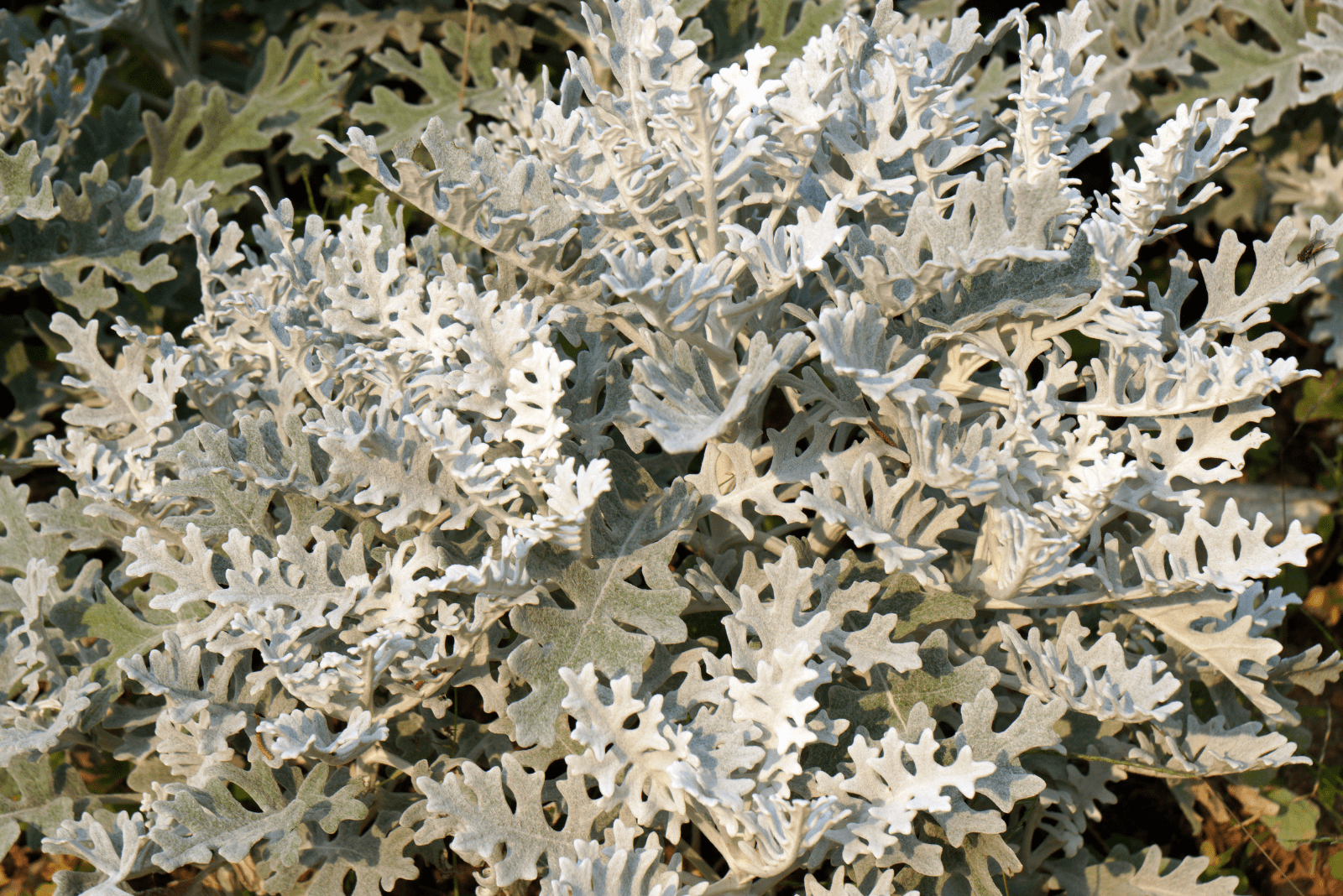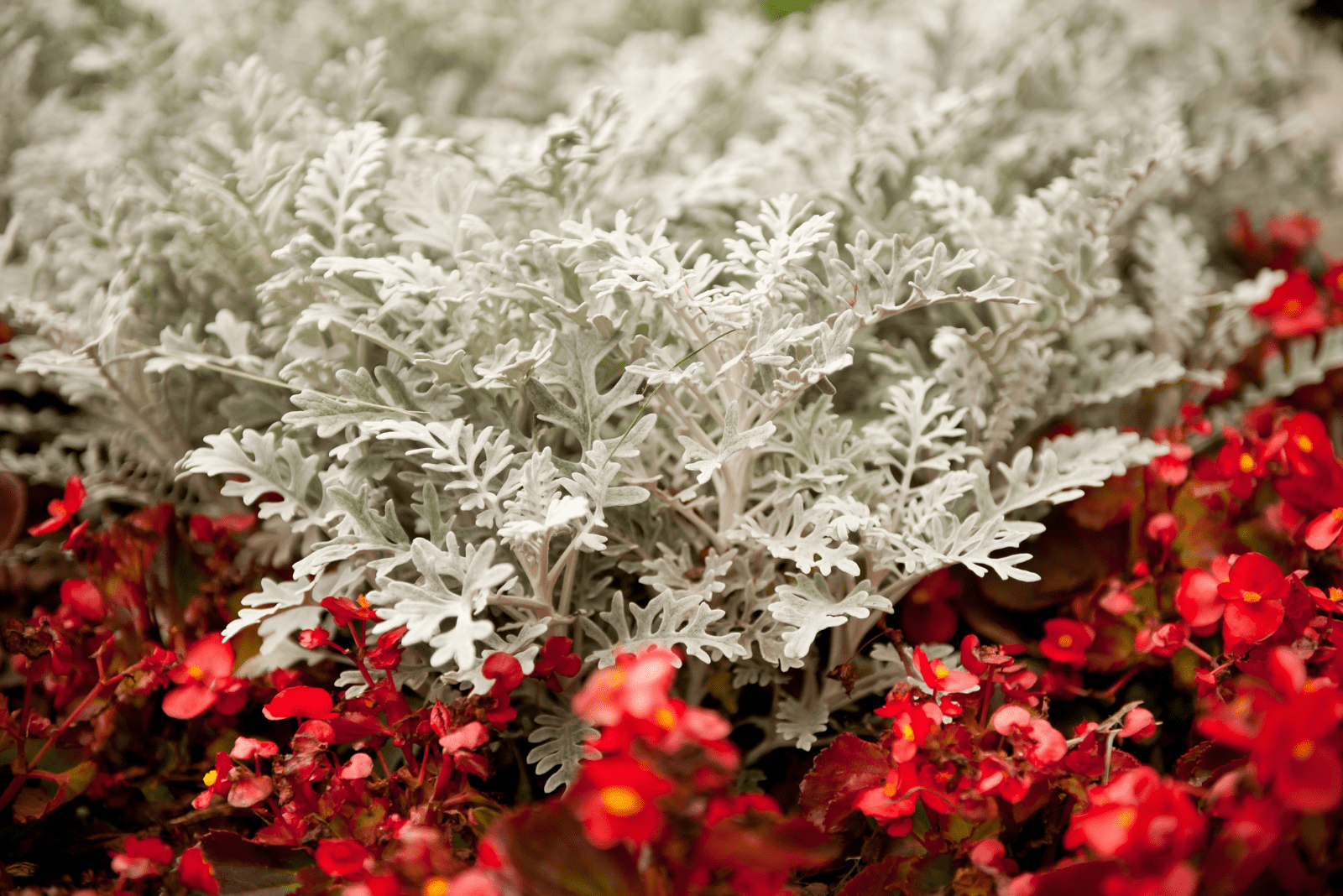The dusty miller is a classic plant, and even though it has been grown for a long time it has never stopped being popular.
There are many reasons for this. First, the dusty miller is a low-maintenance plant and will forgive you if you neglect it for a while. Its silvery foliage also attracts growers as it combines well with many other leaf colors.
Yellow flowers attract pollinators, so growing a dusty miller is great for your whole garden!
Another great feature of this plant is that it grows well with other plants, so let’s learn about all the fantastic dusty miller companion plants .
Before we move on, here’s some basic info:
[table id=215 /]
15 Dusty Miller Companion Plants
The dusty miller gets along well with plants from different families and genera, and its yellow blooms combine well with lots of colors.
You can plant your dusty miller near petunias , begonias , ornamental grasses , salvias , and many others, and they’ll all reap the benefits of each other.
So, what are we waiting for?! Let’s get started!
1. Petunias
Petunias are mostly grown in pots, but are also great plants for borders.
These plants get along well with the dusty miller as both thrive in similar growing conditions.
Here is some basic info:
Scientific name : Petunia spp.
Common names : Petunia
Native habitat : South America
Plant type : Annual
USDA growing zones : 10-11
The petunia ‘s flowers resemble trumpets, and the only color you won’t find on this plant is true blue. This gives plenty of choices for petunias to grow next to a dusty miller with complementing flower colors.
Petunia is a genus of flowering plants, most of which are sold as hybrids.
You can choose the shape of petals as there are both flat and wave petunias . You can also choose one according to its growth habit as there are mounding and cascading petunias .
Finally, if you prefer plants with fragrance, this genus also offers varieties that smell fantastic.
How To Grow Petunias
You’ll need to ensure they get at least 6 hours of full sun per day. However, in the summertime some shade will enhance their blooming and keep the plant fresh.
They can grow in a wide range of soil types as long as they are fertile, slightly acidic, and drain effectively.
These plants are annuals, which means they can’t withstand long periods without water. On the other hand, they won’t grow well in overly moist soil, so give them an inch or two of water per week if there’s no rainfall.
Ideal temperatures for the plants from this genus should range from 60 to 75 degrees Fahrenheit. Slightly lower temperatures can also work well, but anything lower than 40 degrees Fahrenheit may cause damage.
When it comes to humidity, keep it low to moderate. Also fertilize petunias regularly and add compost to the soil.
I recommend varieties such as Phantom, Rose Vein Velvet, and Black Satin.
2. Begonias
Some of the most productive and straightforward begonias to grow are cane-type varieties such as the Angel wing begonia .
These plants are known to attract beneficial insects that keep pests away.
Here is some basic info:
Scientific name : Begonia x corallina
Common names : Angel wing begonia
Native habitat : South America
Plant type : Perennial shrub
USDA growing zones : 10-11
The Angel wing has upright stems, fascinating dotted leaves, distinctive hues, and a stunning display of flowers.
If you can ensure a few vital conditions, these plants aren’t extremely challenging to grow and can be started indoors and grown all year round.
They’ll develop at a somewhat rapid rate, with new growth becoming noticeable in just six weeks.
How To Grow Begonias
Angel wings grow best in bright indirect light. It requires a potting mix rich in organic matter and adequate water-retaining materials. However, waterlogged soil won’t work well for this cultivar .
This plant has an extensive root system and will tolerate slightly compact soil because it needs something to hold its tall stems.
Mist the soil regularly, and don’t let it dry more than an inch below the topsoil.
The ideal temperature for the Angel wing is between 65 to 75 degrees Fahrenheit. If the temperature is below 50 degrees, there is a chance the plant will completely die.
You can fertilize your Angel wing twice a month with a liquid fertilizer diluted to half strength. During the flowering period, apply fertilizers rich in phosphorus to encourage blooming.
I recommend varieties such as Silver Wings, Splish Splash, and Looking Glass.
3. Marigolds
Another perfect dusty miller companion plant is the marigold .
Here is some basic info:
Scientific name : Tagetes spp.
Common names : Marigold
Native habitat : Mexico
Plant type : Herbaceous, annual
USDA growing zones : 2-11
These cheery blooms have fern-like leaves and bright colors. They are true annuals and go through their life cycle in one growing season .
The size and structure of marigold blooms can differ greatly, with either single or double petals.
When started from seeds, these quick-growing plants will reach full blooming maturity in a relatively short time.
How To Grow Marigolds
Find a spot for your marigolds where they will receive full sun for the best blooms and healthiest plants.
These plants will droop and produce fewer flowers in shady areas.
These plants grow well in various types of soil. Maintain a neutral pH between 6.0 and 7.0. They don’t require highly organic matter-rich soil, and actually seem to thrive in lighter soil.
Remember that your marigold seeds or seedlings should receive consistent water when you first plant them; don’t let the soil dry.
Water newly-planted marigolds every day if the weather is especially hot and sunny. They will become more resistant to drought once they have developed strong root systems, but weekly watering is still necessary for them to bloom at their best.
Marigolds prefer warmer temperatures and relatively dry air.
I recommend varieties such as Cottage Red, Discovery Orange, and Janie Deep.
4. Angelonia
Growing angelonias near dusty miller plants is a great opportunity to brighten up your garden. Additionally, angelonias are known for their fragrance, which beneficial insects such as butterflies and bees find attractive.
Here is some basic info:
Scientific name : Angelonia angustifolia
Common names: Angelonia , summer snapdragon
Native habita t: Mexico, South America, West Indies
Plant type : Perennial, annual
USDA growing zones : 9-11 (perennial), 8 and lower (annual)
Angelonia plants are cultivated as both annuals and perennials. If you live in USDA growing zones 8 and lower you can cultivate the angelonia as an annual plant .
On the other hand, in zones 9-11 angelonias are cultivated as perennial plants.
These plants have sturdy stems that produce slender green leaves. On the tips of the stems you can find flowers that resemble orchids in various colors such as pink, white, magenta, and purple.
Many cultivate the summer snapdragon because of its lovely scent, which is incredibly strong during summer.
How To Grow Angelonias
If you want your summer snapdragon to bloom continually, you’ll need to choose a spot where it can receive enough full sun .
Although these plants grow well in various soil types, they favor a pH ranging from 5.5 to 6.2.
The richer the soil, the less water and fertilizer it needs. Raised beds and pots are perfect for these plants.
Angelonia is a drought-tolerant plant, which means that it continues blooming even during dry periods.
Summer snapdragon plants prefer warmer temperatures and high humidity.
These plants aren’t heavy feeders, so fertilizing them once a month is fine. Follow the directions on the product packaging to find out how much to use.
I recommend varieties such as Angelina Dark Rose, AngelMist Spreading Blue, and Carita Cascade Deep Purple.
5. Creeping Phlox
Creeping phlox is an excellent ground cover , particularly in rock gardens. Dusty miller can tolerate drought, but phlox prefers moist soil.
Phlox improves water retention, and also makes your garden look prettier when combined with silver dust .
The fact that the phlox and dusty miller grow well in comparable environments is unquestionably a bonus.
Here is some basic info:
Scientific na me: Phlox stolonifera
Common names : Moss phlox , star rock phlox , creeping phlox
Native habitat : North America
Plant type : Herbaceous, perennial
USDA growing zones : 5-9
This plant features clusters of five-petal and scented blossoms and attracts pollinators, which makes it a perfect companion plant .
The best time to plant phlox is in spring after the last frost .
How To Grow Creeping Phlox
Full sun to low shade is ideal for this plant’s growth. Too much shade may prevent the flowers from blooming.
This plant requires slightly acidic soil but can grow well in neutral substrate. It also requires soil that drains effectively.
Although mature plants can tolerate considerable drought, they prefer moist soil. You will have to water it approximately once a week if there’s no rainfall.
These are hardy plants and may even tolerate some frost. However, if the temperatures are lower than 40 degrees Fahrenheit for an extended period your plant may be damaged.
Feed your plant in the early spring with fertilizer for blooming plants.
I recommend varieties such as Drummond’s Pink, Fort Hill, and Red Wing.
6. Basil
Similarly to dusty millers , basil enjoys full sun . Additionally, the distinctive scent of basil, which is so pleasing to people, will frighten some dangerous pests and reduce weed growth!
Here is some basic info:
Scientific name : Ocimum basilicum
Common names: Sweet basil
Native habitat : Central Africa to Southeast Asia
Plant type : Perennial or annual herb
USDA growing zones : 10-11 (perennial)
Despite coming from India, basil is often associated with Italian cuisine.
Basil features rich green leaves that can be velvety or crinkled. Although the flowers are small, bees seem to love them.
All basil varieties thrive in warm, sunny conditions. The buds are also edible, though the leaves are more frequently used in cooking. This plant grows quickly and does well in both gardens and pots.
How To Grow Basil
Regarding sun exposure, this plant will appreciate 6 to 8 hours of full sun per day. For basil, more sun means stronger roots and fewer diseases.
However, if you live in hot climates you’ll need to provide it with partial shade .
This plant grows best in fertile, moist soil with good drainage. For better results, add compost or mulch .
Mulch will aid in water retainment because basil needs deep watering regularly.
Basil enjoys heat and is extremely sensitive to frost, so delay planting it until the temperature starts rising above 70 degrees Fahrenheit.
Pro tip: Extend the growing season by using row covers, but make sure they don’t touch the delicate foliage.
You’ll need to apply all-purpose fertilizer frequently to encourage new growth .
I recommend varieties such as Cinnamon, Italian Large Leaf, and Emerald Towers.
7. Bugleweed
Bugleweed and dusty miller both love a wet environment and ample sun, so taking care of them together is simple.
Additionally, bugleweed has beautiful purple blossoms that grow vertically into a cone form, which makes for a perfect combination with your dusty miller .
Here is some basic info:
Scientific name : Ajuga reptans
Common names : Bugleweed, carpetweed, carpenter’s herb, carpet bugle, blue bugle
Native habitat : Europe, northern Africa, southwestern Asia
Plant type : Herbaceous perennial
USDA growing zones : 4-9
Bugleweed is a very common ground cover plant that spreads quickly and effectively smothers weeds. It has glossy, deep-green foliage and lovely flower spikes, which can bear eight to ten-inch-tall blooms. The flowers come in blue, violet, or purple.
Some bugleweed varieties have variegated leaves that come in various hues and patterns.
Pay attention to the location where you intend to plant bugleweed as it is a fast-spreader and can quickly take over your garden.
How To Grow Bugleweed
Ensure at least 4 hours of full sun each day to keep the leaves vivid.
Bugleweed thrives in fertile and well-draining soil with moderate moisture.
This perennial requires about an inch of water per week when mature. At the same time, new plants need two inches of water with a good amount of rainfall.
Bugleweed is susceptible to crown rot, and although it thrives in a wide range of temperatures, it always needs good airflow.
Bugleweed isn’t a heavy feeder and doesn’t require any food if the soil is fertile enough.
I recommend varieties such as Black Scallop, Blueberry Muffin, and Toffee Chip.
8. Lithodora
Lithodora plants attract pollinators, which makes them a perfect companion for dusty miller plants .
Here’s some basic info:
Scientific name : Lithodora diffusa
Common names : Lithodora
Native habitat : Europe, Mediterranean
Plant type : Perennial, groundcover , herbaceous
USDA growing zones : 6-8
There are many ways to grow lithodora plants; you can grow them as a groundcover , in containers, or in window boxes .
Lithodora is a hardy plant that produces small, blue star-shaped flowers.
How To Grow Lithodora
Although Lithodora does best in direct sunlight, it can also grow in some shade. It’s actually preferable to ensure some partial shade if you live in very hot climates .
Ensure well-draining and acidic soil. The best option would be sand, but never grow lithodoras in heavy clay.
Once you plant your lithodora, water it deeply once a week. Avoid leaving the soil to dry out entirely, but don’t leave it soggy either or it could lead to root rot .
These plants typically don’t need fertilizing. However, your plant may lack nutrients if the leaves start turning pale. If you notice paling, add liquid fertilizer for acid-loving plants.
This plant is typically hardy in zones 6 to 8, and it won’t tolerate high temperatures or humidity.
I recommend varieties such as Grace Ward, Heavenly Blue, and White Star.
9. Veronica Spicata
You often see Veronicas in fascinating bouquets. Luckily, these plants aren’t attractive to deer and pests but instead attract pollinators, which makes them perfect companions for silver dust .
Here’s some basic info:
Scientific name : Veronica spicata
Common names : Veronica, spiked speedwell, speedwell
Native habitat: Europe, Asia
Plant type: Herbaceous perennial
USDA growing zones : 3-8
Veronica is a genus that consists of over 500 flowering plants. Veronica spicata is the most famous plant from this genus, and many call it speedwell.
It is planted for the long-lasting , magnificent spikes of blooms you will notice when the spring is almost finished.
Veronica isn’t an invasive species, and you can prune it down for the winter before it grows again in the late spring.
How To Grow Veronica Spicata
A lot of direct sun and loamy, well-draining soil will help your Veronica grow healthy and thrive.
I always add compost to the soil before I plant my Veronicas. Don’t forget to water them after adding compost!
Even though mature Veronicas are drought-resistant , you’ll need to water them frequently in the juvenile stages.
Just because they tolerate drought doesn’t mean you should leave them without water – an inch per week should work well.
The spiked speedwells are susceptible to damage from severe winds, so it’s important to safeguard the plants by placing them close to a wall or similar structure for cover.
Don’t worry too much about fertilizing – once a year should be enough.
I recommend varieties such as Sunny Border Blue, Icicle, and Giles Van Hees.
10. Hosta
Hosta plants grow well in both partial shade and direct sun. If you plant a hosta near a silver ragwort , your flower bed will look amazing!
Additionally, both plants keep dangerous pests away and attract pollinators during the flowering season.
Here is some basic info:
Scientific name : Hosta spp.
Common names: Hosta, plantain lily
Native habitat: Eastern Asia
Plant type : Herbaceous perennial
USDA growing zones : 3-9
Hosta is the most commonly grown garden plant in America because they are low-maintenance plants, grow well in the shade, and are easy to propagate.
Most people notice the leaves, but hostas produce blooms as well.
Smaller types of hostas need less time to develop. Avoid planting them during summer because early spring or late fall is ideal.
How To Grow Hosta
Hostas grow well in the shade but benefit from a couple of hours of dappled sunlight.
Hostas can grow in a variety of soil types as long as they drain well. They struggle in clay soil because it retains too much moisture.
They enjoy fertile soil rich in organic materials, and if you grow hostas in pots I suggest using regular commercial potting soil that drains properly.
Mature hostas don’t need much water, but can’t tolerate extended periods of drought.
Plantain lily isn’t picky about humidity or temperature, simply put them where they are shielded from severe winds.
As far as fertilization is concerned, I suggest adding only compost. Another option for feeding them is applying well-balanced fertilizer when the hostas start to emerge in the spring. However, take care to avoid getting any fertilizer grains stuck in the leaves as it can burn them.
I recommend varieties such as Blue Mouse Ears (small variety), Sum and Substance, and Halcyon.
11. Nasturtiums
Nasturtiums are great companion plants because their flowers attract beneficial insects and repel harmful pests.
These plants are frequently referred to as “trap crops” because they trap insects and pests that would otherwise infest surrounding crops.
Here is some basic info:
Scientific name : Tropaeolum spp.
Common names : Nasturtium
Native habitat : Central & South America
Plant type : Annual, perennial
USDA growing zones : 9 to 11
Nasturtiums are common plants due to their low-maintenance requirements. These plants also come in vibrant colors and make a great addition to any flower garden .
These plants will actually thrive if you leave them alone. Nasturtiums have spherical leaves that resemble small lotuses.
There are bushy varieties that make perfect borders and trailing varieties that look magnificent when grown in hanging baskets .
There are also climbing nasturtium varieties, so you can choose various types that would grow next to a silver dust really well .
How To Grow Nasturtiums
First, you’ll need to find a spot in your garden where your nasturtium can receive at least 6 hours of direct sun a day.
A little bit of shade is preferable in hotter climates, though the blooms won’t be as beautiful if they don’t receive enough sun.
Interestingly, these plants hate fertile soil and do better in poor soil with adequate drainage.
Nasturtiums appreciate weekly watering, except when grown in greenhouses. Drought won’t instantly kill these plants, but they may look brittle.
Nasturtiums are grown as perennials in hardiness zones 9-11. They prefer warmer temperatures – anything above 70 degrees Fahrenheit will work fine.
These plants can tolerate light frost, but a cold breeze may kill them.
I recommend varieties such as Peach Melba, Canary Creeper, and Fiery Festival.
12. Candytuft
Both candytuft and dusty miller are deer-resistant , which makes them great companions.
Candytuft can also attract pollinators to your garden, so it benefits all plants!
Here is some basic info:
Scientific name: Iberis sempervirens
Common names : Candytuft
Native habitat: Europe, Mediterranean
Plant type : Perennial, herbaceous, shrub
USDA growing zones : 3-9
Candytuft is a low-growing plant that has oval-shaped green leaves. Although the name may suggest that the plant smells like candy, trust me, it doesn’t. Actually, this plant has a very unpleasant smell.
How To Grow Candytuft
Although candytuft can grow in partial shade , it blooms best in direct sunlight.
These plants prefer rocky soil, but the most important thing is that it needs to drain well.
Watering won’t take much time for your candytuft. You can even skip watering for two to three weeks and your candytuft will still grow well.
If you live in warmer climates , you can grow candytuft as a shrub, and if you live in hardiness zone 3 you will notice it grows as a hardy perennial.
You can skip fertilization if you like, but if you want even more blooms you can apply slow-release and phosphorus-rich fertilizer.
I recommend varieties such as Autumn Snow, Alexander’s White, and Snowflake.
13. Zinnias
Zinnias are mostly grown as border plants and attract pollinators, which makes them great for companion planting .
Here is some basic info:
Scientific name: Zinnia elegans
Common names : Zinnea
Native habitat : South America, southwestern United States, Mexico
Plant type : Annual shrub
USDA growing zones : 2-8 (annual), 9-11 (perennial)
You can find many Zinnia varieties on the market, and new hybrids seem to come out every day! They feature several different types of spherical, brightly colored blooms. There are tall types that can reach a height of 4 feet and beautiful dwarf types.
The most important thing about Zinnias is that they tolerate all conditions.
How To Grow Zinnias
Zinnias should be planted in a location that receives direct sunlight.
The only true necessity for soil is that it has good drainage. The roots dislike sitting in wet soil, and too much moisture increases the likelihood of powdery mildew.
These plants are extremely drought-tolerant and typically don’t require any additional watering.
Don’t worry if the summer gets too hot as it won’t bother zinea much. Don’t worry about fertilizing either – simply apply balanced fertilizer occasionally.
This is what I call a true low-maintenance plant !
I recommend varieties such as Envy, Zahara, and Orange Star.
14. Million Bells
The million bells attract beneficial insects and birds so planting them near your dusty miller is a great idea.
Here is some basic info:
Scientific name : Calibrachoa group
Common names : Million Bells, mini petunia
Native habitat : South America
Plant type : Herbaceous perennial
USDA growing zones : 9-11 (perennial), all zones (annual)
The million bells plant comes in a wide variety of hues and may have patterns, stripes, or double blooms.
This plant blooms profusely, and its 1-inch flowers resemble small petunias , hence the name mini petunia .
How To Grow Million Bells
Ensure a lot of direct sunlight and some shade during hot summer days.
Choose fast-draining soil and enrich it with organic matter if you grow a million bells in garden beds .
Keep the soil constantly moist and water often in summer.
Ensure the temperature ranges from 55 to 65 degrees Fahrenheit and fertilize frequently.
I recommend varieties such as Cabaret Purple Glow, Kabloom, and MiniFamous Double Blue.
15. Salvias
Another great friend of the silver dust is salvia . These plants attract pollinators and are a great garden design idea!
Here is some basic info:
Scientific name : Salvia sylvestris
Common names : May night salvia , woodland sage
Native habitat: Europe, Asia
Plant type : Herbaceous perennial
USDA growing zones : 4-8
These plants are very versatile! The dry leaves are occasionally used in potpourri, some use them as a spice, and they bloom for a long time.
These characteristics, together with the vibrant color of the blossoms, is what makes this perennial so popular.
How To Grow Salvia
The care guide for the salvia sylvestris plant is very simple – ensure full sun , well-draining soil, and a moderate amount of water. You can skip fertilizing.
I recommend varieties such as Divinorum, Argentea, and Splendens.
How To Care For Dusty Miller Plants
Now we know loads of awesome dusty miller companion plants , it’s time to see how to help your Jacobaea Maritima thrive!
Temperature & Humidity
The dusty miller is native to the Mediterranean , so it grows best in warmer climates .
High humidity won’t damage this plant if you put it in a sunny spot with adequate spacing.
Light For A Silver Dust
Make sure your plant receives enough sun so it stays compact and maintains its magnificent silver foliage .
If you notice your dusty miller becoming leggy and developing fewer hairs essential for color, it isn’t receiving enough sun.
Watering & Soil
What keeps this plant standing tall during dry spells is its fuzzy growth. Established plants don’t require much water, and adding mulch will reduce the water needs even more.
The growth of silver ragwort can be maintained with just one inch of water every week.
These plants grow well in various soil types as long as they have sufficient drainage. You can add compost to improve drainage and regulate soil pH.
Fertilizing
These plants aren’t heavy feeders and only require fertilizing if the soil is poor.
Stick to organic fertilization methods, such as adding well-rotted manure.
Wrapping Up
Luckily, dusty miller plants and their varieties, such as cirrus and silver lace , are available in many garden centers .
Your garden will look amazing now that you know all these great dusty miller companion plants !
None of the plants we discussed today, including silver ragwort , will take much of your time, and will reward you well if provided with just a little care.
Therefore, it’s time to plant a dusty miller along with some friends!
Until next time!
Like this post? Share or pin it for later!

